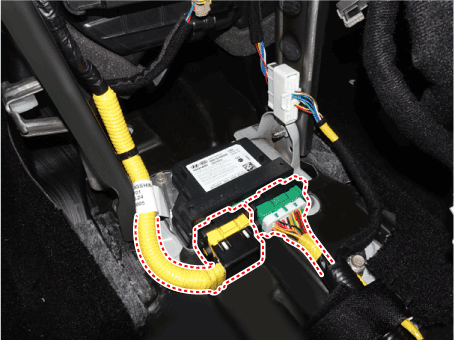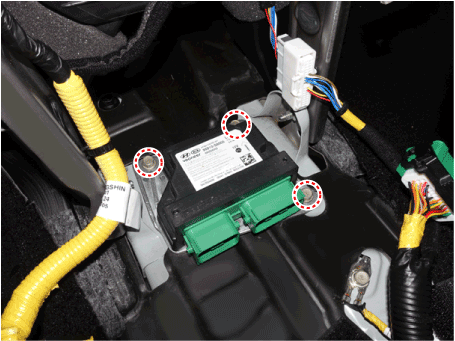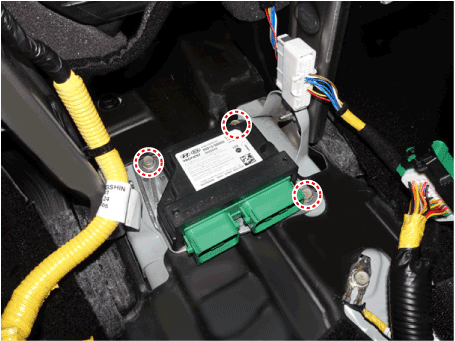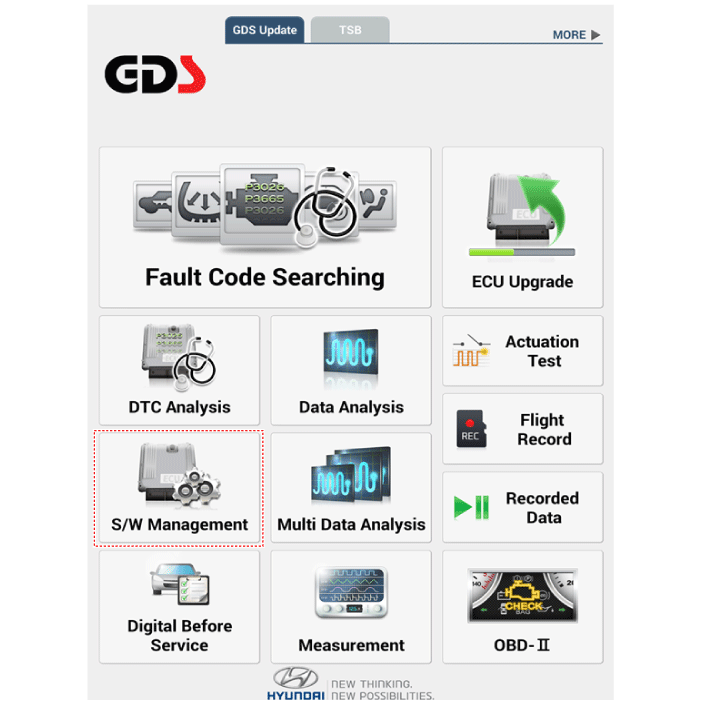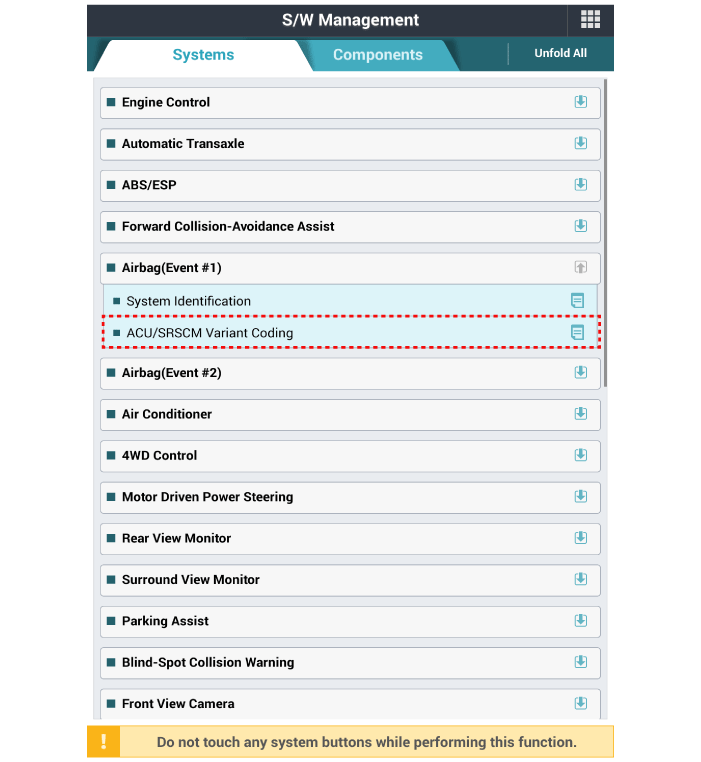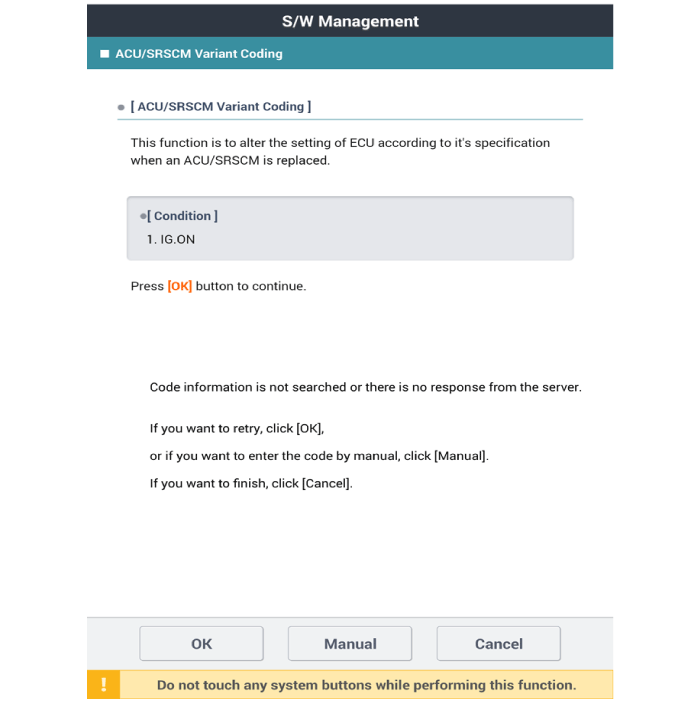Hyundai Palisade: SRSCM / SRS Control Module (SRSCM)
Components and components location
| Components |
| [LH] |
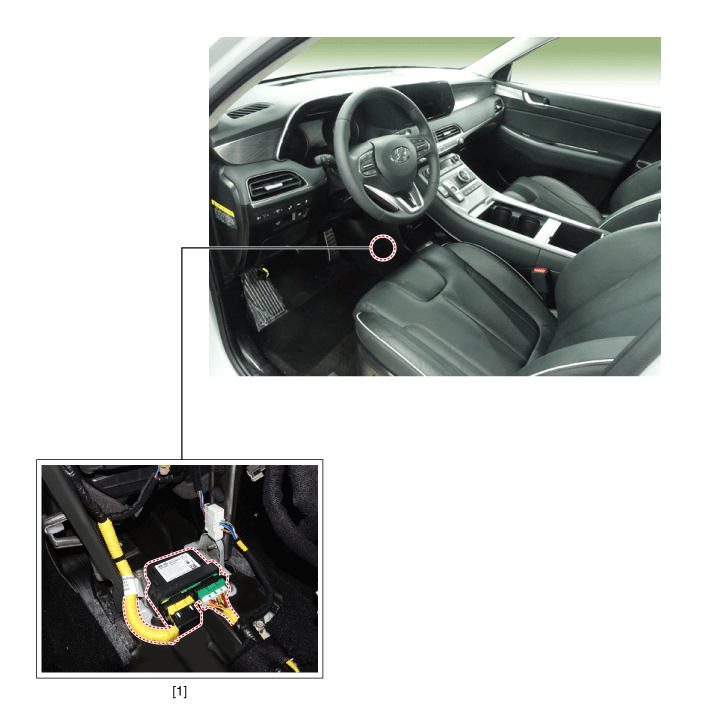
| 1. Supplemental Restraint System
Control Module (SRSCM) |
Description and operation
| Description |
The primary purpose of the SRSCM (Supplemental Restraints System Control Module)
is to discriminate between an event that warrants restraint system deployment
and an event that does not. The SRSCM must decide whether to deploy the restraint
system or not. After determining that pretensioners and/or airbag deployment
is required, the SRSCM must supply sufficient power to the pretensioners and
airbag igniters to initiate deployment.
The SRSCM determines that an impact may require deployment of the pretensioners
and airbags from data obtained from impact sensors and other components in conjunction
with a safing function.
The SRSCM will not be ready to detect a crash or to activate the restraint system
devices until the signals in the SRSCM circuitry is stabilized.
It is possible that the SRSCM could activate the safety restraint devices in
approximately 2 seconds but is guaranteed to fully function after prove-out
is completed.
The SRSCM must perform a diagnostic routine and light a system readiness indicator
when the ignition switch is in the ON position. The system must perform a continuous
diagnostic routine and provide fault notice through a warning lamp indicator
in the event of fault detection. A serial diagnostic communication interface
will be used to facilitate servicing of the restraint control system.
Schematic diagrams
| Supplemental Restraint System Control Module (SRSCM) |
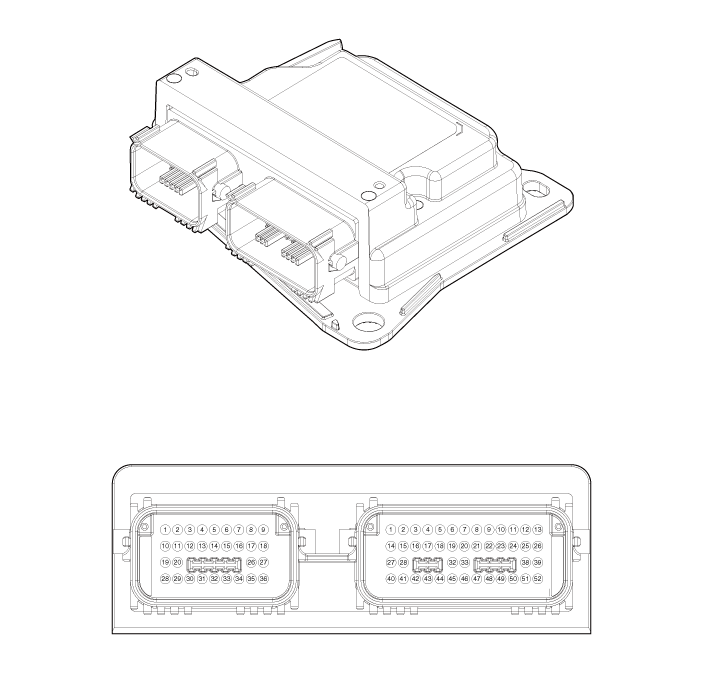
|
No |
Connector A |
Connector B |
|
1 |
- |
- |
|
2 |
- |
- |
|
3 |
- |
- |
|
4 |
- |
- |
|
5 |
- |
- |
|
6 |
- |
- |
|
7 |
- |
- |
|
8 |
- |
- |
|
9 |
- |
- |
|
10 |
B+ |
- |
|
11 |
Crash output |
- |
|
12 |
Passenger airbag 1st stage (Low) |
- |
|
13 |
Passenger airbag 1st stage (High) |
- |
|
14 |
- |
- |
|
15 |
- |
- |
|
16 |
Passenger airbag OFF lamp |
- |
|
17 |
Passenger airbag ON lamp |
Passenger curtain airbag (Low) |
|
18 |
- |
Passenger curtain airbag (High) |
|
19 |
Driver airbag 1st stage - (High) |
Driver curtain airbag (High) |
|
20 |
Driver airbag 1st stage (Low) |
Driver curtain airbag (Low) |
|
21 |
- |
Passenger side airbag (Low) |
|
22 |
- |
Passenger side airbag (High) |
|
23 |
- |
Driver side airbag (High) |
|
24 |
- |
Driver side airbag (Low) |
|
25 |
- |
- |
|
26 |
C-CAN (Low) |
- |
|
27 |
C-CAN (High) |
Driver seat belt pretensioner (Low) |
|
28 |
IGN 1 |
Driver seat belt pretensioner (High) |
|
29 |
Front driver impact sensor LH - (High) |
- |
|
30 |
Front impact sensor LH - (Low) |
- |
|
31 |
Front impact sensor RH - (Low) |
- |
|
32 |
Front impact sensor RH - (High) |
Passenger seat belt pretensioner (High) |
|
33 |
- |
Passenger seat belt pretensioner (Low) |
|
34 |
- |
- |
|
35 |
P-CAN (Low) |
- |
|
36 |
P-CAN (High)) |
- |
|
37 |
|
- |
|
38 |
- |
|
|
39 |
- |
|
|
40 |
Ground |
|
|
41 |
Driver side rear impact sensor (Low) |
|
|
42 |
Driver side rear impact sensor (High) |
|
|
43 |
Driver pressure side impact sensor (High) |
|
|
44 |
Driver pressure side impact sensor (Low) |
|
|
45 |
Passenger pressure side impact sensor (Low) |
|
|
46 |
Passenger pressure side impact sensor (High) |
|
|
47 |
Driver side impact sensor (High) |
|
|
48 |
Driver side impact sensor (Low) |
|
|
49 |
Passenger side impact sensor (Low) |
|
|
50 |
Passenger side impact sensor (High) |
|
|
51 |
Passenger side rear impact sensor (High) |
|
|
52 |
Passenger side rear impact sensor (Low) |
Repair procedures
| Removal |
| 1. |
Turn the engine OFF.
|
| 2. |
Disconnect the battery negative cable and wait for at least three minutes
before beginning work.
|
| 3. |
Remove the floor console assembly.
(Refer to Body - "Floor Console Assembly")
|
| 4. |
Loosen the mounting bolts and then remove the air duct.
|
| 5. |
Pull up the lock of the SRSCM connector to disconnect the connector.
|
| 6. |
Remove the SRSCM mounting bolts and then remove the SRSCM.
|
| Installation |
| 1. |
Turn the engine OFF.
|
| 2. |
Disconnect the battery negative cable and wait for at least three minutes
before beginning work.
|
| 3. |
Install the SRSCM with the SRSCM mounting bolts (3EA).
|
| 4. |
Connect the SRSCM harness connector.
|
| 5. |
Install the rear air duct.
|
| 6. |
Install the floor console assembly.
(Refer to Body - "Floor Console Assembly")
|
| 7. |
Reconnect the battery negative cable.
|
| 8. |
After installing the SRSCM, confirm proper system operation:
Turn the ignition switch ON; the SRS indicator light should be turned
on for about six seconds and then go off.
|
| Variant Coding |
After replacing the SRSCM with a new one, the “Variant Coding” procedure must
be performed.
Variant Coding Procedure
| 1. |
Connect the cable of GDS to the data link connector in driver side crash
pad lower panel, and turn on the GDS.
|
| 2. |
Select the 'S/W Management' and 'Car model'.
|
| 3. |
Select "Airbag" and "ACU/SRSCM Variant Coding".
|
| 4. |
Perform the "ACU/SRSCM Variant Coding" procedure according to the GDS
screen message.
|
 Components and components location
Components and components location
Components
1. Supplemental Restraint System
Control Module (SRSCM)
2. Rear Gravity side Impact Sensor (G-SIS)
3...
 Front Impact Sensor (FIS)
Front Impact Sensor (FIS)
Components and components location
Components
1. Front impact sensor (FIS)
2. Front impact sensor (FIS)
Description and operation
Description
The front impact sensor (FIS) is installed in the Front End Module (FEM)...
Other information:
Hyundai Palisade (LX2) 2020-2025 Service Manual: Description and operating principle
Description and Operation Wireless Power Charger System During ACC or IG ON, battery voltage is supplied to the wireless power charger system to transmit an output of 5 W to mobile phone. Mobile phones certified with the wireless charging standard WPC (Qi 1...
Hyundai Palisade (LX2) 2020-2025 Service Manual: Fuel pressure test (low pressure system)
Fuel Pressure Test (Low pressure system) 1. Release the residual pressure in fuel line. (Refer to Fuel Delivery System - "Release Residual Pressure in Fuel Line") • When removing the fuel pump fuse, a Diagnostic Trouble Code (DTC) may occur...
Categories
- Manuals Home
- 1st Generation Palisade Owners Manual
- 1st Generation Palisade Service Manual
- Removing and Storing the Spare Tire
- Side view mirror adjustment, Folding the side view mirrors
- Rear center seatbelt (3rd row)
- New on site
- Most important about car
Manual adjustment
The front seat can be adjusted by using the levers located on the outside of the seat cushion. Before driving, adjust the seat to the proper position so that you can easily control the steering wheel, foot pedals and controls on the instrument panel.
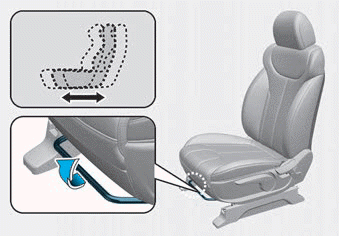
Copyright © 2025 www.hpalisadelx.com

